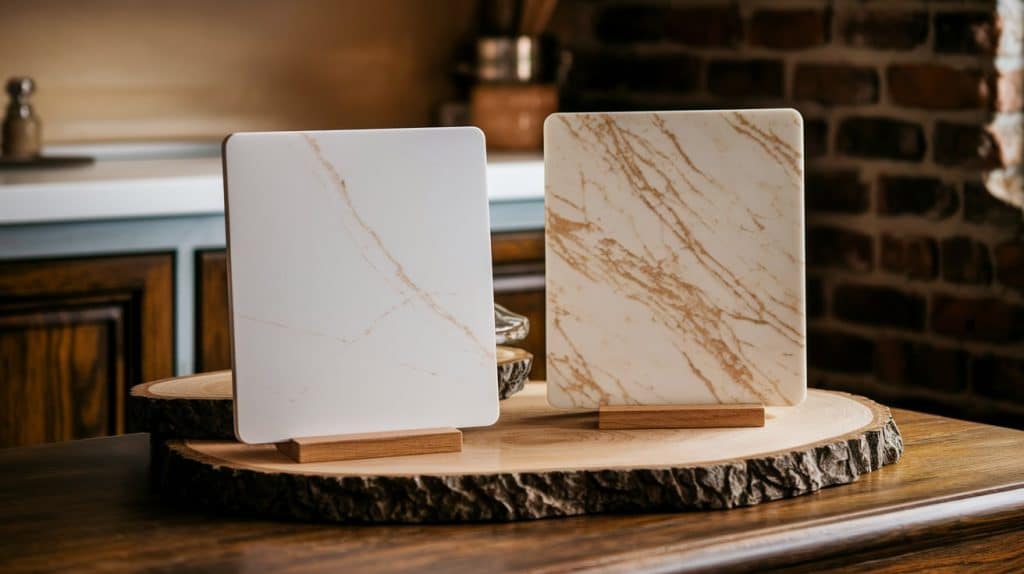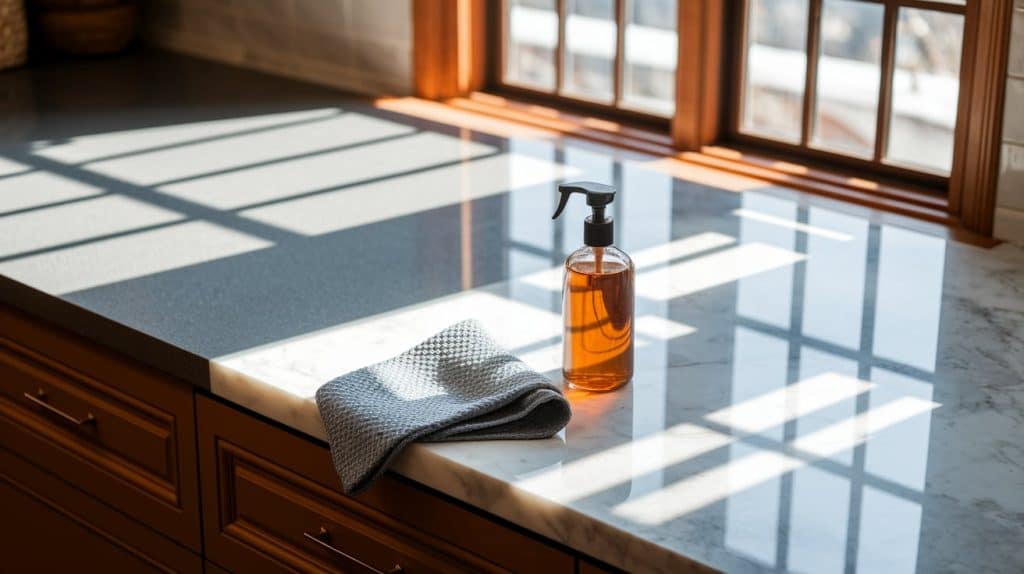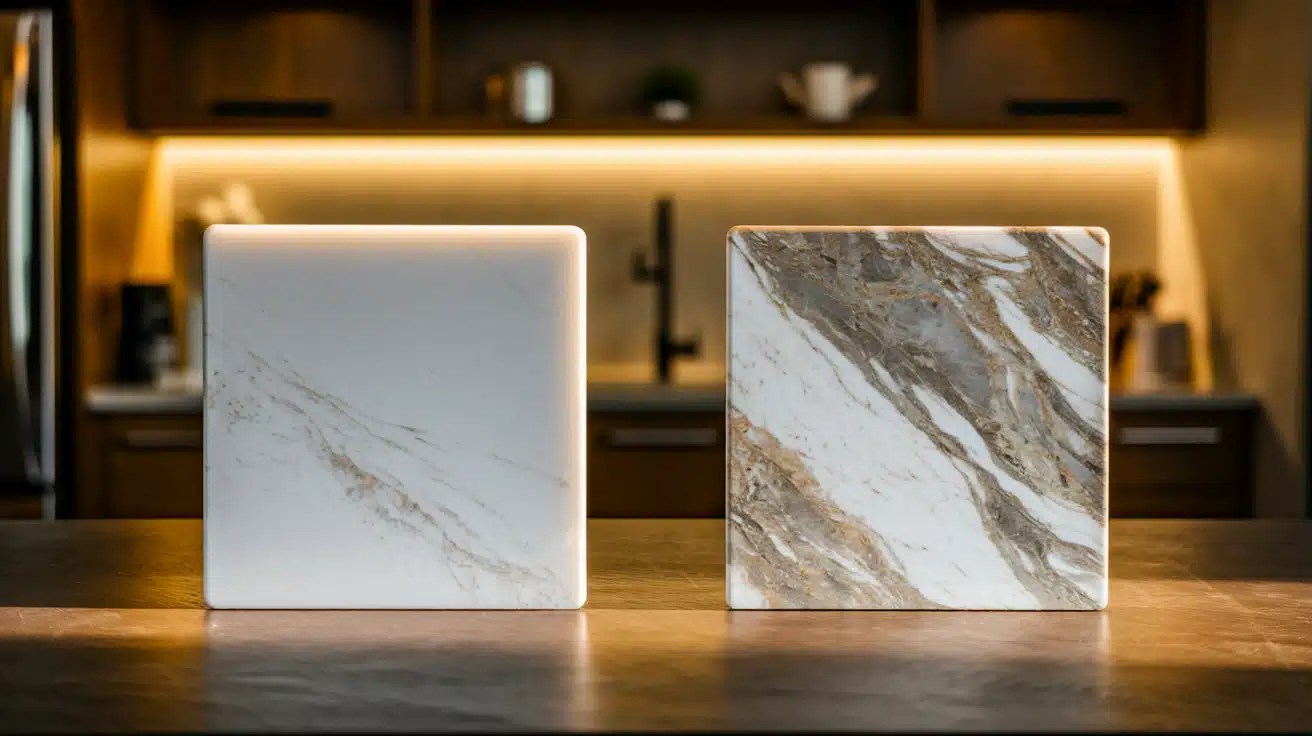Choosing the right countertop can make or break your kitchen renovation. You want something that looks great, handles daily life, and fits your budget.
Both quartz and marble offer beautiful surfaces, but they work very differently in real homes. Quartz offers durability and easy care, making it perfect for busy families.
Marble brings luxury and timeless beauty, but it needs more attention. The wrong choice means years of regret, extra costs, or surfaces that don’t match your actual lifestyle.
This guide compares quartz and marble across key areas: durability, cost, appearance, maintenance, environmental impact, and suitability for various uses.
You’ll get the facts you need to pick the perfect countertop for your lifestyle and budget.
What is Quartz?
Quartz countertops are made from crushed natural quartz crystals mixed with resin and pigments. This engineered process creates a surface that resists scratches and stains better than natural stone.
The manufacturing method makes quartz non-porous, which means liquids won’t seep through. You can choose from hundreds of colors and patterns to match your kitchen style.
Quartz offers the perfect blend of strength and beauty for busy families. Its low maintenance needs and long-lasting performance make it a smart investment for modern homes.
Quartz Countertops: Pros and Cons
| Pros | Cons |
|---|---|
| Scratch, stain, and impact-resistant | Can be damaged by excessive heat |
| More affordable than marble | High-end options can be pricey |
| Wide range of colors and customizable patterns | Lacks natural uniqueness, uniform appearance |
| Low maintenance, no sealing needed | Prone to staining from harsh chemicals or heat |
| More eco-friendly options are available | Manufactured with resins, a larger environmental footprint |
What is Marble?
Marble is a natural stone that forms when limestone goes through heat and pressure over thousands of years. This process creates the beautiful veins and patterns that make each marble slab one-of-a-kind.
No two pieces look exactly the same, giving your home a truly unique look. Marble has been the choice of luxury for centuries, from ancient palaces to modern high-end kitchens.
Its timeless beauty and classic appeal make any space feel more refined. The natural veining patterns create visual interest that never goes out of style. Homeowners choose marble when they want to add instant luxury and sophistication to their space.
Marble Countertops: Pros and Cons
| Pros | Cons |
|---|---|
| Timeless elegance and unique natural beauty | Prone to scratches, stains, and etching |
| Adds luxury and value to a home | Expensive upfront cost and installation |
| Unique natural veining | Requires regular sealing and maintenance |
| Easy to clean with gentle care | Quarrying has an environmental impact |
Quartz vs Marble Countertops: Key Differences

Discover the key differences between quartz and marble countertops, including durability, cost, maintenance, and aesthetic appeal, to help you select the ideal material for your home.
1. Durability
Quartz: Engineered to resist scratches, stains, and chips better than most natural stones. The resin binding makes it nearly indestructible for daily kitchen tasks.
Perfect for busy kitchens where kids spill juice and parents chop vegetables on a daily basis. Heat-resistant up to 300°F, though hot pans can still cause damage. Expected to last 15-20 years of heavy use before showing signs of wear.
Marble: Soft natural stone that scratches easily from everyday kitchen knives. Red wine leaves permanent stains that penetrate deep into the stone.
Lemon juice creates dull spots, known as etching, within minutes of contact. Better suited for powder rooms than busy kitchens, where accidents happen daily. Requires gentle handling and immediate cleanup of all spills.
2. Cost
Quartz: Generally costs $50-90 per square foot installed, making it more budget-friendly than premium marble. Costs less upfront and saves money over time with minimal maintenance needs.
No annual sealing fees that add up over decades. Fewer repairs needed means lower lifetime costs. Price stays consistent across different colors and patterns, making budgeting easier for homeowners.
Marble: Premium slabs range from $60 to $120 per square foot installed, with rare varieties costing much more. Carrara marble sits on the lower end while Calacatta commands premium prices.
Factor in sealing costs every 1-2 years, at $200-$ 400 per application. Repair costs for chips, cracks, and stains can add thousands over the stone’s lifetime.
3. Appearance
Quartz: Offers hundreds of colors and patterns, from solid whites to dramatic veining that mimics natural stone. Engineered consistency means your kitchen island matches your perimeter counters perfectly.
Great for modern, clean designs that demand uniformity. Can replicate the look of marble, granite, or concrete without the limitations of natural stone. New patterns emerge yearly, keeping design options fresh and current.
Marble: Each slab tells a unique story through its natural veining, created over millions of years. Classic white Carrara brings timeless Italian villa charm to any kitchen.
Dramatic Calacatta creates bold focal points with thick, contrasting veins. No two slabs match exactly, making your countertops truly one-of-a-kind. Adds instant luxury and sophistication that impresses guests and increases home value.
4. Maintenance
Quartz: Daily cleaning requires only soap and water or gentle household cleaners. No special pH-balanced products needed, like natural stone demands. Never requires sealing, saving time and money every year.
Stain-resistant surface means red wine and coffee accidents wipe away easily. Busy families love the low-maintenance lifestyle it provides. A non-porous surface prevents bacterial growth, making it naturally hygienic.
Marble: Requires sealing every 12-24 months to maintain stain resistance and appearance. Special pH-neutral cleaners only – regular household cleaners can damage the surface permanently.
Clean all spills immediately or face permanent staining and etching. Acidic foods like tomatoes, citrus, and vinegar cause instant damage. A high-maintenance relationship that requires constant attention and care from homeowners.
5. Environmental Impact
Quartz: The Manufacturing process combines natural quartz with synthetic resins and polymers in energy-intensive factories. Transportation from overseas manufacturing centers adds to the carbon footprint.
However, a long lifespan reduces the need for replacement. Some manufacturers now use recycled materials and sustainable practices. Consider local sourcing when possible to reduce environmental impact.
Marble: Fully natural material extracted from quarries with minimal chemical processing required. Lower manufacturing energy compared to engineered products.
Local sourcing reduces transportation emissions significantly. Quarrying has an impact on natural landscapes and ecosystems. Stone lasts generations when properly maintained, reducing long-term environmental impact through longevity.
6. Best Use
Quartz: Perfect for kitchen islands where families gather and spills happen frequently. Ideal for bathroom vanities in busy family bathrooms. Great choice for outdoor kitchens in covered areas.
Excellent for commercial applications like restaurants and offices. Anywhere durability and easy maintenance matter more than natural stone character.
Marble: Stunning in master bathroom vanities where luxury and beauty take priority. Perfect for fireplace surrounds and decorative accent walls. Excellent for formal dining room sideboards and butler’s pantries.
Ideal for low-traffic areas where its natural beauty can shine without daily wear concerns. The best choice for creating timeless, high-end spaces that impress.
How to Care for Quartz vs Marble Countertops

Learn how to properly care for quartz and marble countertops to maintain their beauty and longevity, from cleaning tips to essential maintenance practices.
| Aspect | Quartz Countertops | Marble Countertops |
|---|---|---|
| Maintenance | Low maintenance, easy to clean, no sealing required | Requires regular sealing and more frequent maintenance |
| Cleaning | Clean with mild soap and water, a non-abrasive cloth | Use pH-balanced cleaner, avoid acidic cleaners (e.g., vinegar) |
| Stain Resistance | Stain-resistant, less likely to absorb liquids | Prone to staining from acidic substances (e.g., wine, citrus) |
| Scratch Resistance | Highly resistant to scratches | Prone to scratches and etching, especially from sharp objects |
| Sealing | No sealing needed | Must be sealed regularly to maintain protection |
| Lifespan | Can last 20+ years with proper care | It can last 20+ years with proper care, but it requires more attention |
| Long-Term Care | Very low maintenance, occasional cleaning suffices | Needs regular sealing and careful maintenance to preserve appearance |
Brands of Quartz vs Marble Countertops
Study top brands that offer high-quality quartz and marble countertops, renowned for their durability, design variety, and craftsmanship, to help you make an informed choice for your home.
1. Top Brands of Quartz Countertops
- Caesarstone is known for its high-quality quartz surfaces, offering a wide range of colors and finishes that are renowned for their durability and design flexibility.
- Silestone: A popular brand offering various styles and sustainable options, Silestone quartz countertops are stain-resistant and highly durable.
- Cambria: A luxury quartz brand, Cambria is famous for its premium designs and eco-friendly production processes.
2. Top Brands of Marble Countertops
-
Carrara Marble: Famous for its classic white and gray veining, Carrara marble is one of the most sought-after options in luxury kitchen and bathroom designs.
-
Calacatta Marble: Renowned for its bold and dramatic veining, Calacatta marble is frequently utilized in high-end design projects for a striking appearance.
-
Statuario Marble: A premium marble with beautiful, delicate veining, often used in luxury homes for a sleek, sophisticated finish.
Which is the Best Option for Your Home?
Your choice between quartz and marble depends on how you live and what matters most to your family.
Busy households with kids, pets, and frequent cooking should opt for quartz due to its durability and easy cleanup. It handles spilled grape juice and pizza nights without stress.
Quartz works best in kitchens, family bathrooms, and high-traffic areas where daily life occurs. Choose marble when you want luxury and timeless beauty in spaces like master bathrooms, powder rooms, or formal dining areas where careful use is expected.
Consider your budget not just for the purchase but also for ongoing maintenance – quartz saves money in the long term, while marble requires regular sealing and special care. If you love cooking and need worry-free surfaces, pick quartz.
If you want Instagram-worthy luxury and don’t mind extra care, marble creates the sophisticated look you’re after.
Wrapping It Up
Quartz and marble both bring unique benefits to your home, but the right choice depends on your lifestyle and priorities.
Quartz wins for busy families who need durability, stain resistance, and low maintenance in high-traffic kitchens. Marble excels in creating luxurious spaces where natural beauty takes precedence over daily durability.
Do you cook frequently with messy ingredients? Do kids eat snacks at the counter? Choose quartz for peace of mind. Want to create a spa-like master bathroom or impress dinner guests? Marble delivers unmatched natural beauty.
Your budget plays a big role, too. Quartz costs less upfront and saves money on maintenance over time. Marble requires a higher initial investment plus ongoing sealing and special care costs.
Ready to start your countertop project? Visit local showrooms to see both materials in person. Touch the surfaces, compare colors, and talk to professionals about your specific needs.
Frequently Asked Questions
What’s Better, Marble or Quartz?
Quartz is better for most homeowners because it’s more durable, stain-resistant, and requires less maintenance than marble.
What Is the Downside to Quartz Countertops?
The main downside is that hot pans can permanently damage quartz surfaces, and it costs more upfront than some natural stones.
How Can you Tell Quartz from Marble?
Drop lemon juice on the surface – marble will etch and show dull spots while quartz stays unchanged.
Can you Put a Hot Pan on Quartz?
No, hot pans above 150°F can permanently damage quartz, so always use trivets or hot pads.








